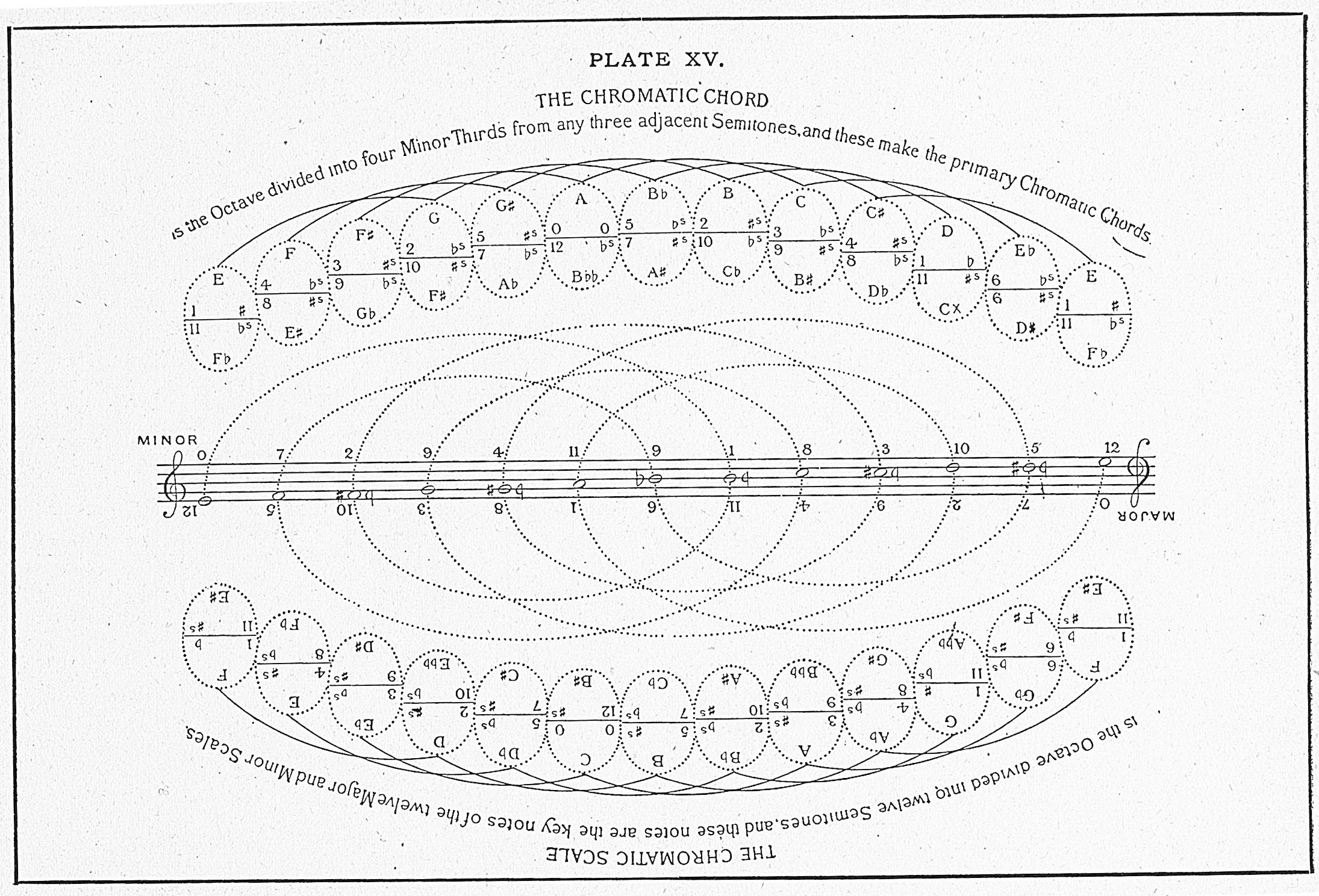
One purpose of this plate is to show that twelve times the interval of a fifth divides the octave into twelve semitones; and each of these twelve notes is the first note of a major and a minor scale. When the same note has two names, the one has sharps and the other has flats. The number of sharps and flats taken together is always twelve. In this plate will also be observed an exhibition of the omnipresence of the chromatic chords among the twice twelve scales. The staff in the center of the plate is also used as to show the whole 24 scales. Going from the major end, the winding line, advancing by fifths, goes through all the twelve keys notes; but in order to keep all within the staff, a double expedient is resorted to. Instead of starting from C0, the line starts from the subdominant F0, that is, one key lower, and then following the line we have C1, G2, etc., B6 proceeds to G? instead of F#, but the signature-number continues still to indicate as if the keys went on in sharps up to F12, where the winding line ends. Going from the minor end, the line starts from E0 instead of A0 - that is, it starts from the dominant of A0, or one key in advance. Then following the line we have B1, F#2, etc. When we come to D#5, we proceed to B? instead of A#6, but the signature-number continues as if still in sharps up [Scientific Basis and Build of Music, page 114]
In the festoons of ellipses the signatures are given in the usual conventional way, the major F having one flat and minor E having one sharp. The major and minor keys start from these respective points, and each successive semitone is made a new keynote of a major and a minor respectively; and each ellipse in the festoons having the key shown in its two forms; for example, in the major F, one flat, or E#, eleven sharps; in the minor E, one sharp, or F?, eleven flats. Thus is seen all the various ways that notes may be named. The four minor thirds which divide the octave may be followed from an ellipse by the curved lines on which the ellipses are hung; and these four always constitute a chromatic chord. [Scientific Basis and Build of Music, page 115]
The image you've shown is a diagram of the chromatic scale in music theory, focusing on how the octave is divided into twelve semitones, and illustrating the key notes of major and minor scales. Here's a breakdown of the different components and what they represent:
1. **Chromatic Scale**: At the top of the diagram, there are two rows of circles each containing pairs of notes. These circles represent the twelve semitones (or half steps) that make up the chromatic scale. Each semitone is a step from one note to the next closest note, either up or down.
2. **Major and Minor Scales**: Below the circles, the diagram shows lines connecting certain notes, depicting the intervals found in major and minor scales. Major scales are generally characterized by a specific sequence of intervals (whole, whole, half, whole, whole, whole, half), while minor scales typically have a different pattern (whole, half, whole, whole, half, whole, whole).
3. **Key Notes in Scales**: The lines connect the key notes used in constructing the twelve major and minor scales. Each scale is built from a different root note, and the diagram uses arrows and numbers to show the intervallic relationships between notes in these scales.
4. **Numbered Arrows**: These arrows likely represent the sequence of intervals in major (outer ring) and minor (inner ring) scales starting from different root notes. The numbers along these arrows might correspond to the scale degrees or to specific intervals used to form the scales from their respective roots.
5. **Musical Notation**: At the center bottom, there's a standard musical staff with a clef and notes, providing a visual of a scale in standard musical notation. This helps in connecting the abstract interval relationships shown in the diagram with how they are traditionally written in music.
This kind of diagram is useful for visual learners in music theory as it illustrates how scales are constructed from a root note and the relationships between different scales. It serves as a visual map to understanding the fundamental structure of Western tonal music. [Seth Ricord]
See Also
